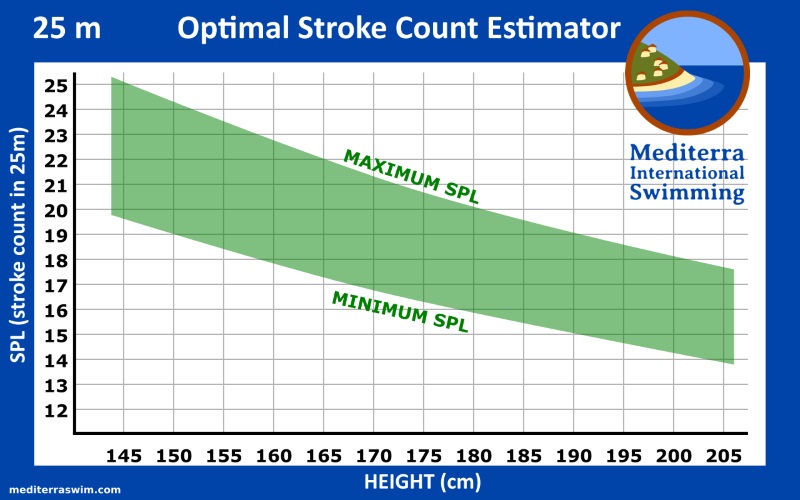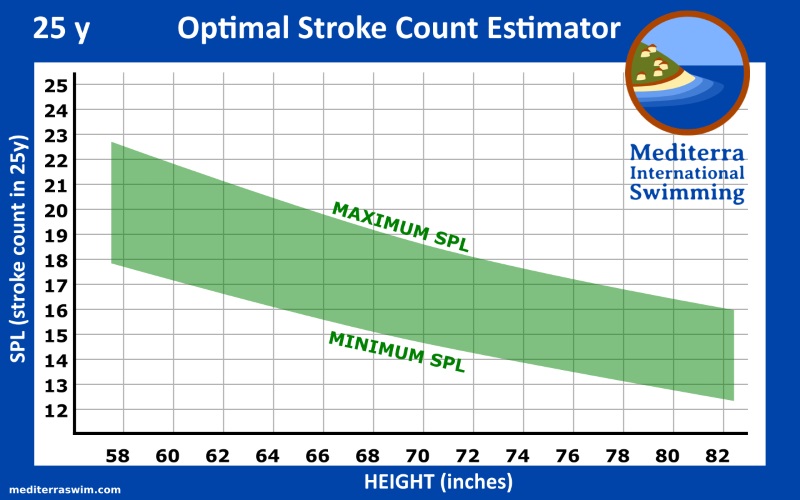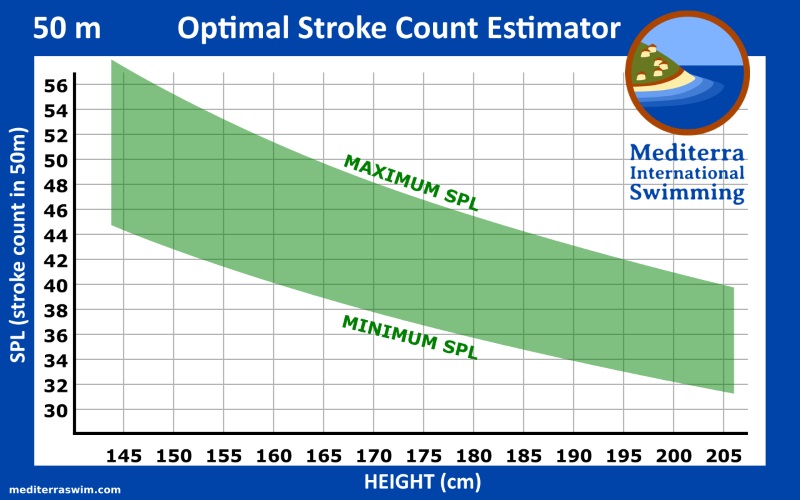How Can We Help?
Optimal Stroke Count Charts for your ‘Green Zone’
These charts below will help you estimate your optimal Strokes-Per-Length (SPL) range for various pool lengths. This is sometimes referred to as your Green Zone.
These charts are just to help you aim in the right direction. There are many factors you should consider when fine tuning which range of stroke counts are best for your body and event. Read When Choosing Your Optimal Stroke Count for more insight, and you might enjoy reading The Back Story Of The Stroke Count Charts to learn about how they were created.
Your Precise SPL Range
This chart estimates a range of about 5 SPL points. However, through testing and practice we recommend that you narrow your personal range down to 3 SPL points.
For example, for a male swimmer about 40 years old, 180 cm tall, the chart above suggests a 16-20 SPL in a 25 meter pool. If he has highly developed streamline and stroke efficiency he may aim for 16-18 SPL as his target SPL range. If less developed he may aim for 18-20 SPL.
What Is This Range For?
Changing SPL during a swim functions a bit like switching gears on your bicycle, allowing you to adjust the pressure and frequency of the stroke to use energy just the way you need to for a particular event or conditions.
Your higher SPL count is generally for shorter distance, higher tempo, or lighter pressure strokes. Your lower SPL count is generally for longer distances, lower tempo, or higher (steady) pressure strokes.
25 METER Pool
This chart is for SPL in a 25 meter pool, assuming you take a 5 meter from push-off to first stroke.

25 YARD Pool
This chart is for SPL in a 25 yard pool, assuming you take a 5 yards from push-off to first stroke.

50 METER Pool
This chart is for SPL in a 50 meter pool, assuming you take a 5 meter from push-off to first stroke.

Switching Between 25 METER and 25 YARD
If you switch between 25 m and 25 yd pools a rough rule-of-thumb is to allow for a 2 stroke count difference between your SPL in the two pools. A 25 meter pool is approximately 2.3 yards longer than a 25 yard pool, and that extra distance equals about 2 strokes for people of middle height range.
Terminology
In practices listed here on the TI Academy, when we refer to SPL, we will use terms like N, N-1, N+1, etc. N = the lowest number in your optimal SPL Range.
It’s not the lowest SPL you can possibly achieve, but the lowest within the range of appropriate SPL for your continuous swimming – in that range that is good for your energy use and shoulder health.
If you have an SPL Range of 16 to 19, then your N = 16, N+1 = 17, N+2 = 18, N-1 = 15, etc.
How These Charts Were Calculated
Based on observation of swimmers and comparison of data we see a strong case for setting a swimmer’s SPL range between 55% and 70% of their wingspan. The minimum SPL on this chart corresponds to 55% of height and the maximum corresponds to 70%.
We chose to use height for these charts because most people know immediately what their height is, and for estimation purposes, that is close enough. Wingspan is the measurement of your arms spread wide, measured from finger tip to finger tip. Wingspan provides the more accurate estimate of what your stroke length potential is. In humans height is approximately the same as wingspan, within +/- 5% margin of difference.
We see this difference between height and wingspan also matters but we’ll save that discussion for another article.
Precise Personal Metrics
If you want to do the math to get more precise, personalized SPL for yourself you need this data:
- Your wingspan (W)
- Your pool length (PL)
- The distance of your glide to stroke #1 (DG)
Then we start the calculations working with Stroke Length (SL).
Calculate your minimum 55% SL: W x .55 = min SL
Calculate your maximum 70% SL: W x .70 = max SL
Then we convert from SL to SPL which is dependent on your pool length and glide.
Calculate your minimum SPL: (PL – DG) / max SL = min SPL
Calculate your maximum SPL: (PL – DG) / min SL = max SPL
Consistent Push-Off Matters
How far you glide after pushing off from the wall to your first stroke affects your stroke count. If you followed the math calculations above you’ll notice that a short push-off will require you to take an extra stroke or two to reach the far wall, while a long one will allow you to take one or two strokes less.
Work on keeping this push-off and glide distance consistent on every lap. If you have a long glide (5-6 meters) you can aim for a lower end of your SPL range. If you have a shorter glide (3-4 meters) you can aim for the higher end of your SPL range. 4-5 meter push-off to glide is a good average to aim for.
